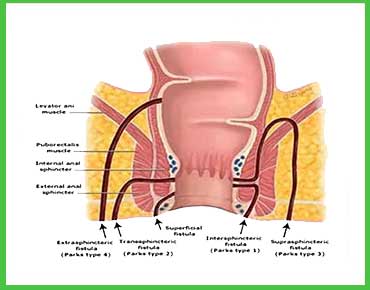
Fistula
A fistula-in-ano is an abnormal tract connecting the anal canal to the perianal skin. It is typically a complication of an anal abscess, which is an infected cavity filled with pus. The drainage of the abscess can lead to the formation of a tunnel that opens externally on the skin. Consulting a fistula specialist at Indu Wellness Piles Speciality Laser Hospital in PCMC, Pune, ensures accurate diagnosis and effective treatment.
Types of Anal Fistulas
Anal fistulas are categorized based on their anatomical relationship with the anal sphincter muscles
1. Intersphincteric Fistula (45% of cases)
- The most common type
- The fistula enters through the internal sphincter but does not involve the external sphincter.
2. Transphincteric Fistula (30% of cases)
- The fistula passes through both internal and external sphincters.
3. Suprasphincteric Fistula (20% of cases)
- The fistula penetrates the internal sphincter, extends above the external sphincter, and opens in the perineum.
- May include a horseshoe-shaped abscess.
4. Extrasphincteric Fistula (5% of cases)
- A rare condition where the fistula connects the rectum to the perineum, bypassing the external and internal sphincters.
- Difficult to treat due to the need to preserve the sphincter mechanism.
5. Subcutaneous/Submucosal Fistula
- A superficial, brief fistula that does not affect the sphincter muscles.
Symptoms of Anal Fistula
Common symptoms include:
- Swelling and pain around the anal region
- Fever and chills in some cases
- Redness, itching, or soreness at the anal opening
- Pus or fluid drainage from the anal opening
For persistent symptoms, seeking advice from a fistula specialist is recommended for timely and appropriate fistula treatment.
Causes of Anal Fistula
- Perianal Abscess: The most common cause.
- Inflammatory Conditions: Such as Crohn’s disease and diverticulitis.
- Tuberculosis: When it affects the anal region.
Chronic anal fissures, caused by infections or pus in unhealed wounds, can progress into fistula. Early fissure treatment can help avoid fistula formation.
Diagnosis of Anal Fistula
Diagnosis involves:
1. Physical Examination
- A fistula specialist inspects the anal region for external openings or drainage.
2. Fistula Probe
- A thin probe is used to trace the fistula tract, often with a dye for internal visualization.
3. Anoscope
- A scope is used to examine the anal canal internally.
4. Imaging Studies
- Ultrasound: Uses sound waves to create an image of the anal area.
- MRI: Provides detailed imaging for complex fistulas
Treatment Options for Anal Fistula
Surgical Treatments:
1. Fistulotomy
- The fistula is surgically opened to heal from the inside out. This is usually an outpatient procedure and one of the most common forms of fistula treatment.
2. Reconstructive Surgery
- Performed in stages for complex fistulas under the guidance of a skilled fistula specialist.
3. Seton Placement
- A suture or rubber band (seton) is placed in the fistula to promote gradual healing and reduce the risk of incontinence.
Ayurvedic Treatment:
1. Ksharsutra Surgery
- Involves the application of a medicinal thread containing herbal extracts.
- Acts as a chemical cauterization agent and is effective for recurrent fistulas.
- This Ayurvedic fistula treatment has a high success rate with minimal side effects.
This complete guide explains the causes, symptoms, and available options for fistula treatment, emphasizing the importance of consulting a specialist for proper care. Visit Indu Wellness Piles Speciality Laser Hospital for more details about treatment options and proper care.





